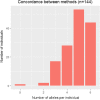Benchmarking the HLA typing performance of Polysolver and Optitype in 50 Danish parental trios
- PMID: 29940840
- PMCID: PMC6019707
- DOI: 10.1186/s12859-018-2239-6
Benchmarking the HLA typing performance of Polysolver and Optitype in 50 Danish parental trios
Abstract
Background: The adaptive immune response intrinsically depends on hypervariable human leukocyte antigen (HLA) genes. Concomitantly, correct HLA phenotyping is crucial for successful donor-patient matching in organ transplantation. The cost and technical limitations of current laboratory techniques, together with advances in next-generation sequencing (NGS) methodologies, have increased the need for precise computational typing methods.
Results: We tested two widespread HLA typing methods using high quality full genome sequencing data from 150 individuals in 50 family trios from the Genome Denmark project. First, we computed descendant accuracies assessing the agreement in the inheritance of alleles from parents to offspring. Second, we compared the locus-specific homozygosity rates as well as the allele frequencies; and we compared those to the observed values in related populations. We provide guidelines for testing the accuracy of HLA typing methods by comparing family information, which is independent of the availability of curated alleles.
Conclusions: Although current computational methods for HLA typing generally provide satisfactory results, our benchmark - using data with ultra-high sequencing depth - demonstrates the incompleteness of current reference databases, and highlights the importance of providing genomic databases addressing current sequencing standards, a problem yet to be resolved before benefiting fully from personalised medicine approaches HLA phenotyping is essential.
Keywords: Clinical genomics; HLA genotyping; NGS; Population genetics; Prediction.
Conflict of interest statement
Ethics approval and consent to participate
The parent–offspring trios (mother–father–child) in the Danish Pan-Genome were selected from the Copenhagen Family Bank [35, 48]. The study protocol was reviewed and approved by The Danish National Committee on Health Research Ethics (file number 1210920, submission numbers 36615 and 38259), as described in [36].
Consent for publication
Not applicable
Competing interests
The authors declare that they have no competing interests.
Publisher’s Note
Springer Nature remains neutral with regard to jurisdictional claims in published maps and institutional affiliations.
Figures



Similar articles
-
Investigations of sequencing data and sample type on HLA class Ia typing with different computational tools.Brief Bioinform. 2021 May 20;22(3):bbaa143. doi: 10.1093/bib/bbaa143. Brief Bioinform. 2021. PMID: 32662817 Free PMC article.
-
Utilizing nanopore sequencing technology for the rapid and comprehensive characterization of eleven HLA loci; addressing the need for deceased donor expedited HLA typing.Hum Immunol. 2020 Aug;81(8):413-422. doi: 10.1016/j.humimm.2020.06.004. Epub 2020 Jun 25. Hum Immunol. 2020. PMID: 32595056 Free PMC article.
-
A New Human Leukocyte Antigen Typing Algorithm Combined With Currently Available Genotyping Tools Based on Next-Generation Sequencing Data and Guidelines to Select the Most Likely Human Leukocyte Antigen Genotype.Front Immunol. 2021 Oct 1;12:688183. doi: 10.3389/fimmu.2021.688183. eCollection 2021. Front Immunol. 2021. PMID: 34659196 Free PMC article.
-
New challenges, new opportunities: Next generation sequencing and its place in the advancement of HLA typing.Hum Immunol. 2021 Jul;82(7):478-487. doi: 10.1016/j.humimm.2021.01.010. Epub 2021 Feb 5. Hum Immunol. 2021. PMID: 33551127 Review.
-
Human Leukocyte Antigen Typing by Next-Generation Sequencing.Clin Lab Med. 2018 Dec;38(4):565-578. doi: 10.1016/j.cll.2018.07.006. Epub 2018 Oct 5. Clin Lab Med. 2018. PMID: 30420053 Review.
Cited by
-
Artificial intelligence and neoantigens: paving the path for precision cancer immunotherapy.Front Immunol. 2024 May 29;15:1394003. doi: 10.3389/fimmu.2024.1394003. eCollection 2024. Front Immunol. 2024. PMID: 38868767 Free PMC article. Review.
-
Investigations of sequencing data and sample type on HLA class Ia typing with different computational tools.Brief Bioinform. 2021 May 20;22(3):bbaa143. doi: 10.1093/bib/bbaa143. Brief Bioinform. 2021. PMID: 32662817 Free PMC article.
-
HLA class-I and class-II restricted neoantigen loads predict overall survival in breast cancer.Oncoimmunology. 2020 Apr 1;9(1):1744947. doi: 10.1080/2162402X.2020.1744947. eCollection 2020. Oncoimmunology. 2020. PMID: 32523802 Free PMC article.
-
Personalized neoantigen pulsed dendritic cell vaccine for advanced lung cancer.Signal Transduct Target Ther. 2021 Jan 20;6(1):26. doi: 10.1038/s41392-020-00448-5. Signal Transduct Target Ther. 2021. PMID: 33473101 Free PMC article. Clinical Trial.
-
TruNeo: an integrated pipeline improves personalized true tumor neoantigen identification.BMC Bioinformatics. 2020 Nov 18;21(1):532. doi: 10.1186/s12859-020-03869-9. BMC Bioinformatics. 2020. PMID: 33208106 Free PMC article.
References
-
- Wilson J, Hunt T. Molecular biology of the cell. 4. New York: Garland Science; 2002. T cells and MHC proteins; p. 711.
-
- Fitch WM, Ayala FJ, National Academy of Sciences (U.S.) Tempo and mode in evolution: genetics and paleontology 50 years after Simpson. Washington, D.C.: National Academy Press; 1995. Molecular Genetics of Speculation and Human Origins; p. viii, 325. - PubMed
Publication types
MeSH terms
Substances
LinkOut - more resources
Full Text Sources
Other Literature Sources
Research Materials

